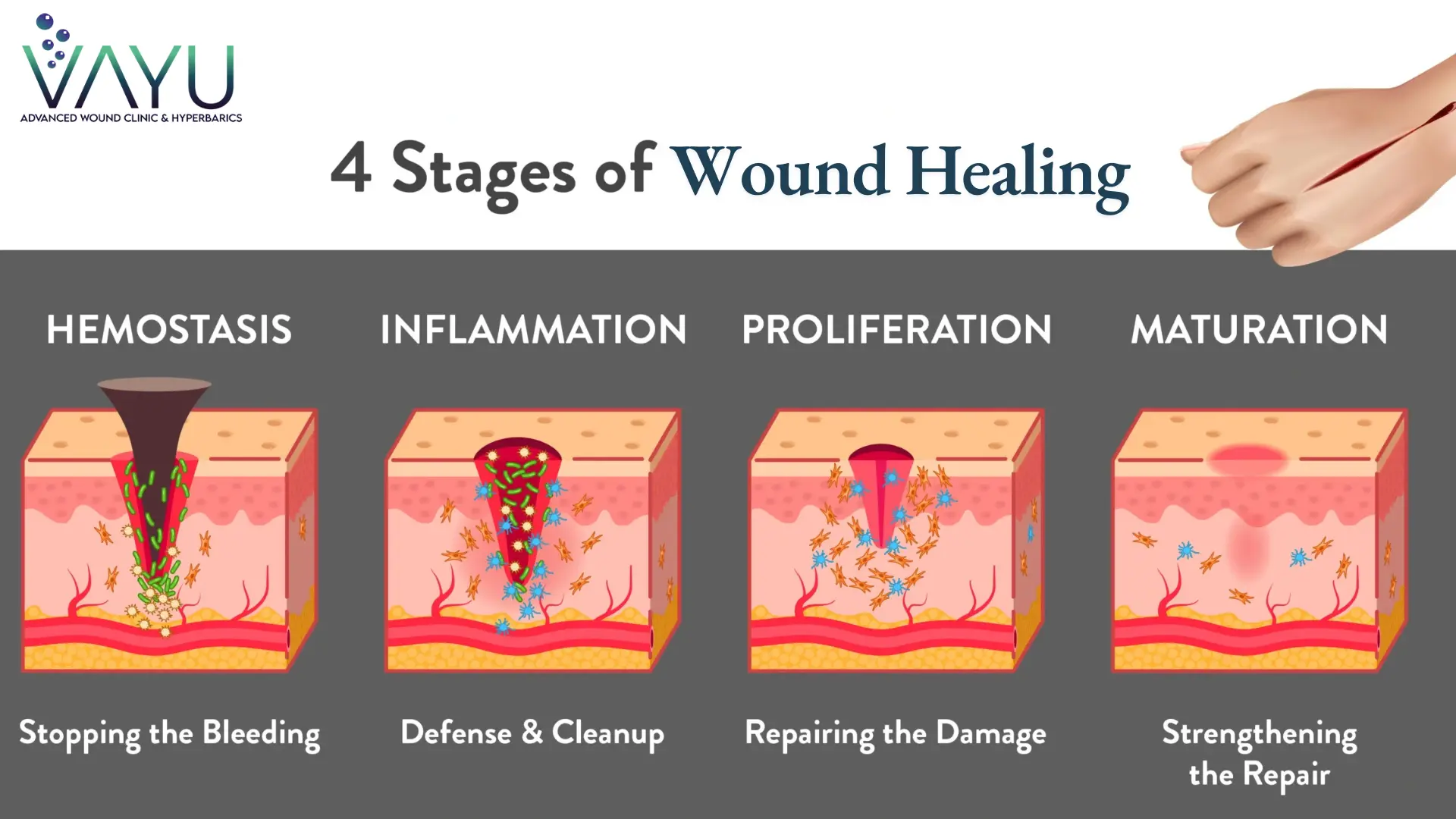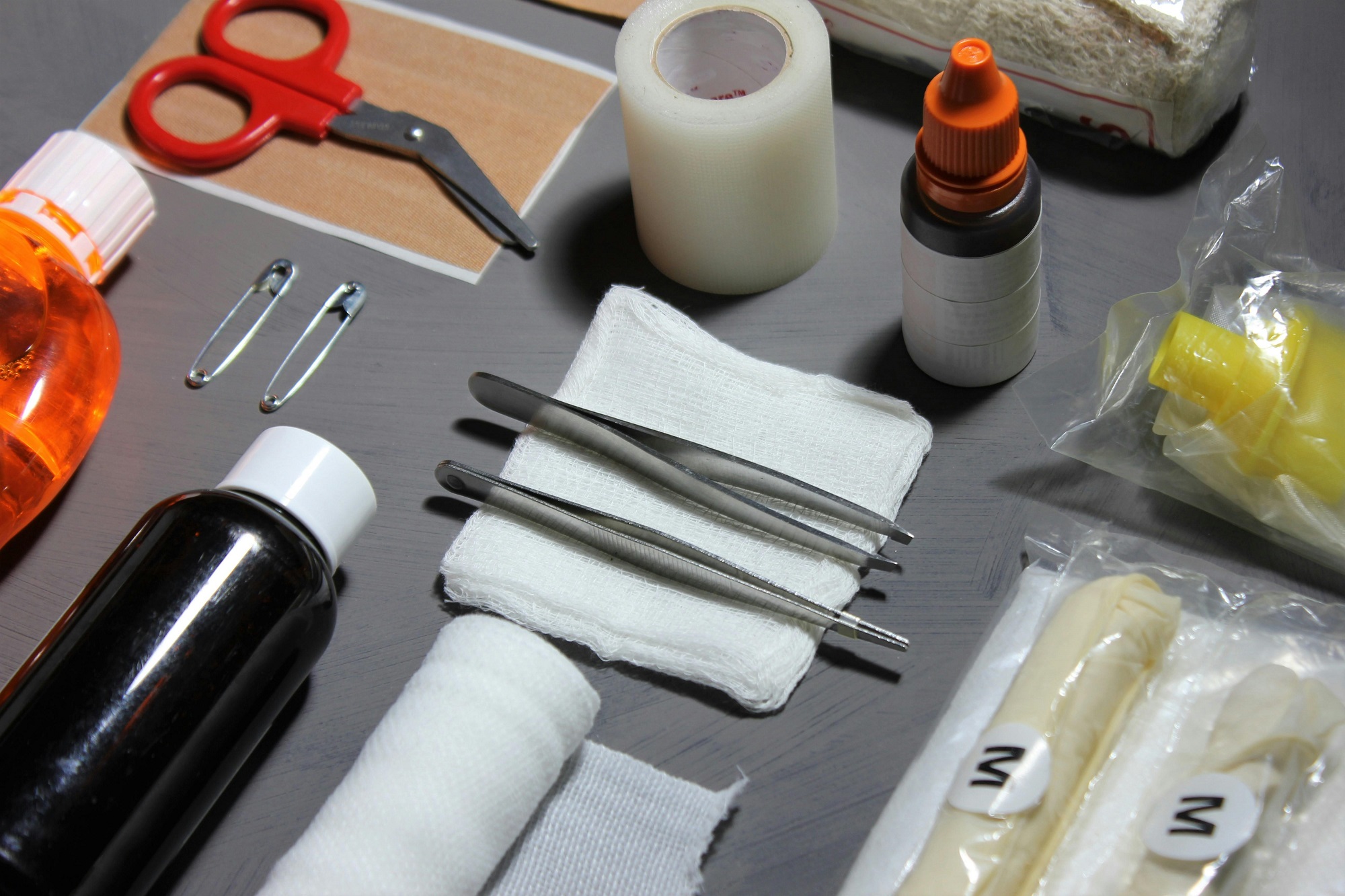Ever wonder what happens when you get an injury that cuts through or damages your skin? Your body immediately springs into action with a remarkable process known as wound healing. While this natural response works tirelessly to repair and restore, certain wounds may require specialized care to heal properly. This is where advanced wound care treatments come into play.
From minor injuries to chronic wounds, these expert approaches ensure faster recovery and reduce the risk of complications. Let’s examine the 4 stages of wound healing and explore effective ways to support your body’s recovery process.
4 Wound Healing Stages: A Step-by-Step Guide

Stage 1: Hemostasis – Stopping the Bleed
Your body’s priority is to stop the bleeding. This is done through a process called hemostasis. First, the blood vessels near the wound contract to slow the blood flow. Then, platelets rush to the scene of the injury. They stick together to form a clot. This clot acts like a plug, sealing the wound so no foreign particles can enter. The clot later hardens and forms the foundation of the scab.
During this stage, you might notice the wound bleeding for a few minutes. This is normal as your body is still forming the clot. With the bleeding halted, the wound looks red or swollen. You may also see some clear fluid leaking out. This is nothing to worry about right now. It’s all part of wound healing.
Stage 2: Inflammation – Defending Against Infection
With the bleeding on hold, your immune system kicks in to protect against infection. White blood cells, known as neutrophils and macrophages, arrive at the wound site to fight off any bacteria, debris, and dead cells that should not be there. Think of this like the cavalry coming in to get rid of harmful invaders. To aid the immune team, your body increases the blood flow again to make more oxygen and nutrients available.
Due to all these changes, you’ll notice the wound site and the area around it swell. There may also be redness, some warmth, and even pain. While it might look like things are getting worse, for now, it is just part of your body’s natural response. This swelling usually doesn’t last more than a week, but it depends on the severity of the wound. However, if the swelling or other signs persist or worsen, you will need medical attention.
Stage 3: Proliferation – Rebuilding Tissue
As your body gets things back under control, it shifts gears to rebuilding. This is known as proliferation. New tissue, known as granulation tissue, begins to form over the wound. It is usually pink or red and appears slightly bumpy or shiny because tiny blood vessels are growing inside. Cells known as fibroblasts are also part of this process. They produce collagen, a protein that acts as a scaffolding to strengthen the newly formed tissue. At the same time, the edges of the wound start to pull together.
Stages of a Scab
With time, you will notice that the wound is gradually getting smaller and smaller. Yet, the surface will look uneven and discolored as a thin scab forms on top. You may feel some itching around the scab. Once the skin beneath is completely healed, the scab will shed, revealing the scar tissue underneath. The wound is now fully closed. However, it is not 100% healed. There is still one more stage to go.
Stage 4: Maturation – Strengthening the Skin
Now is the time to strengthen the once-wounded tissue to make it as durable as possible. The collagen fibers produced during the previous stage are fitted in, making the wound site stronger and more elastic. However, this takes time – anywhere from a few weeks to several months. It may even take a year or more if your wound is deep or covers more area.
The scar tissue, which starts off feeling tight or stretched, will start to relax. Additionally, it will slowly flatten and change color, often fading to your natural skin tone. Now, your wound is completely healed. However, it is important to note that even though the process is over, the once-damaged area will never be as strong as it was before the injury.
Understanding these incision healing stages can help you care for a wound properly and ensure it heals without complications. Always avoid picking at a scab, as this can delay healing and increase the risk of infection.
Ways to Accelerate Wound Healing

While our body is an extraordinary machine, capable of wound healing, research has shown there are several ways we can speed up the processes. Here are some key strategies that can help get you back on your feet faster.
Wound Healing Bandages
Modern bandages are more than just a protective layer. These innovative coverings are specially designed with agents such as silver, which has natural antimicrobial properties. Research shows silver-infused bandages continuously release ions that prevent the growth of bacteria and other disease-causing particles. They also keep the wound cleaner and at the perfect moisture level.
Nutritional Support
To repair itself properly, your body needs the right nutrients, which makes a diet rich in vitamins, minerals, and proteins crucial. Nutrients like vitamin C, zinc, and protein are vital in producing collagen and tissue repair. While your body is in wound-healing mode, it is critical to get enough of these nutrients.
Hyperbaric Oxygen Therapy
Hyperbaric Oxygen Therapy (HBOT) is an incredible, non-invasive treatment that enhances the body’s natural healing processes. By providing pure oxygen in a pressurized room or chamber, HBOT significantly boosts the amount of oxygen the body absorbs. This increase in oxygen is vital for reducing inflammation, fighting infection, and forming new blood vessels. For those with conditions such as diabetes or foot ulcers, HBOT treatment can be especially beneficial. It can improve circulation, jumpstarting healing in chronic wounds and difficult-to-treat diabetic foot ulcers.
Expert Wound Care
If your wound is severe and at an advanced stage without signs of proper healing, expert wound care may be in order. Sometimes, the best way to heal wounds is by enlisting the help of professionals. Expert wound care specialists are trained to assess and manage wounds with precision. They use their knowledge to clean, dress, and monitor wounds. Not only does this reduce the risk of complications, but it also promotes faster recovery.
Wound Healing with Expert Care
Wound healing is a tremendous journey. From the moment of injury to the finishing touches, your body goes through hundreds of processes to repair and restore. While there is no denying the natural power of our biology, incorporating advanced therapies makes quite a difference. Treatments like HBOT can give your body the best chance to heal swiftly and effectively.
Find Exceptional Advanced Wound Care at Vayu
If you’re finding yourself in need of expert guidance or looking for ways to speed up your recovery from an advanced wound, visit Vayu Advanced Wound Care and Hyperbarics. Here, you can find top-notch wound care and cutting-edge treatments. Whether it’s personalized care from our specialists or the benefits of HBOT, we’re dedicated to helping you achieve the best possible outcomes.
Have an advanced wound and are ready to take the next step toward faster healing? Contact us today to schedule a consultation. Let’s work together to get you back on track and feeling your best.
The Healing Stages of a Wound (and What to Expect, Including Venous Ulcers)
Wound healing occurs in four key stages: hemostasis, inflammation, proliferation, and maturation. When an injury happens, the body first forms a clot to stop bleeding (hemostasis), followed by inflammation, where the immune system fights infection and clears debris. In the proliferation phase, new tissue and blood vessels grow, gradually closing the wound. Finally, in the maturation stage, the wound strengthens, and scar tissue forms. However, chronic wounds like venous ulcers heal much slower due to poor circulation. Treatments like Hyperbaric oxygen therapy (HBOT) can enhance healing by increasing oxygen supply to damaged tissues. Proper wound care, including cleaning, moisture balance, and infection prevention, is crucial. If a wound isn’t healing properly, medical intervention is necessary.
Common FAQs About Wound Healing
1. What is a scab, and why does it form?
A. A scab is a protective crust that forms over a wound as part of the body’s natural healing process. It develops when blood clots and dries, creating a barrier that shields the wound from bacteria and debris, allowing the skin underneath to heal.
2. How long does it take for a scab to heal?
A. The healing time for a scab depends on the severity of the wound. Minor scabs usually heal within a week or two, while deeper wounds may take several weeks or longer. Proper care can help speed up the process.
3. Should I pick at a scab?
A. No, picking at a scab can delay healing and increase the risk of infection or scarring. It’s best to let the scab fall off naturally as the skin underneath heals.
4. Why does a scab itch, and what can I do about it?
A. Itching is a common sign that a wound is healing, as the new skin forms and nerve endings are stimulated. To avoid irritation, keep the area clean and moisturized, and resist the urge to scratch.
5. Can a scab become infected?
A. Yes, a scab can become infected if bacteria enter the wound. Signs of infection include increased redness, swelling, warmth, pain, or pus. If you notice these symptoms, consult a healthcare provider promptly.
6. What can I do to help a scab heal faster?
A. To promote faster Scab healing:
- Keep the wound clean and covered with a bandage.
- Apply an antibiotic ointment as directed.
- Avoid picking or scratching the scab.
- Maintain a healthy diet rich in vitamins like C and zinc.
7. When should I seek medical attention for a scab or wound?
A. You should see a doctor if:
- The wound does not show signs of healing after a few weeks.
- There is excessive pain, swelling, or redness.
- You notice pus, a bad odor, or other signs of infection.
- You have a chronic condition, such as diabetes, that affects healing.
8. How does a healing wound look like?
A. A healing wound typically goes through several visible changes:
- Initially, it may appear red, swollen, and tender.
- As healing progresses, you’ll notice the formation of granulation tissue, which is pink or red and may appear slightly bumpy.
- Over time, the wound edges pull together, and a scab forms on top.
- Once the scab falls off, new skin underneath may look lighter or pinkish before blending with your natural skin tone.
9. How long does it take for a deep wound to heal?
A. The healing time for a deep wound depends on its size and location, as well as your overall health. Generally:
Minor deep wounds may heal in 2–4 weeks.
Severe or large deep wounds can take months or even over a year to fully heal, particularly if complications like infection occur.
Proper wound care, good nutrition, and advanced treatments can help speed up the process.

